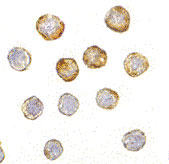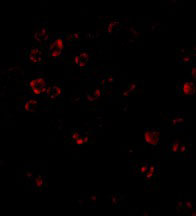DISC1 Antibody
- 产品详情
- 实验流程
- 背景知识
Application
| WB, IF, ICC, E |
|---|---|
| Primary Accession | Q9NRI5 |
| Other Accession | NP_061132, 61742823 |
| Reactivity | Human, Mouse |
| Host | Rabbit |
| Clonality | Polyclonal |
| Isotype | IgG |
| Calculated MW | 93611 Da |
| Concentration (mg/ml) | 1 mg/mL |
| Conjugate | Unconjugated |
| Application Notes | DISC1 antibody can be used for detection of DISC1 by Western blot at 0.5 - 2 µg/mL. Antibody can also be used for immunocytochemistry starting at 5 µg/mL. For immunofluorescence start at 20 µg/mL. |
| Gene ID | 27185 |
|---|---|
| Other Names | Disrupted in schizophrenia 1 protein, DISC1, KIAA0457 |
| Target/Specificity | DISC1; At least four isoforms of DISC1 are known to exist; this antibody will detect the three longest isoforms. |
| Reconstitution & Storage | DISC1 antibody can be stored at 4℃ for three months and -20℃, stable for up to one year. As with all antibodies care should be taken to avoid repeated freeze thaw cycles. Antibodies should not be exposed to prolonged high temperatures. |
| Precautions | DISC1 Antibody is for research use only and not for use in diagnostic or therapeutic procedures. |
| Name | DISC1 (HGNC:2888) |
|---|---|
| Synonyms | KIAA0457 |
| Function | Involved in the regulation of multiple aspects of embryonic and adult neurogenesis (PubMed:19303846, PubMed:19502360). Required for neural progenitor proliferation in the ventrical/subventrical zone during embryonic brain development and in the adult dentate gyrus of the hippocampus (By similarity). Participates in the Wnt-mediated neural progenitor proliferation as a positive regulator by modulating GSK3B activity and CTNNB1 abundance (PubMed:19303846). Plays a role as a modulator of the AKT-mTOR signaling pathway controlling the tempo of the process of newborn neurons integration during adult neurogenesis, including neuron positioning, dendritic development and synapse formation (By similarity). Inhibits the activation of AKT-mTOR signaling upon interaction with CCDC88A (By similarity). Regulates the migration of early-born granule cell precursors toward the dentate gyrus during the hippocampal development (PubMed:19502360). Inhibits ATF4 transcription factor activity in neurons by disrupting ATF4 dimerization and DNA-binding (By similarity). Plays a role, together with PCNT, in the microtubule network formation (PubMed:18955030). |
| Cellular Location | Cytoplasm. Cytoplasm, cytoskeleton Mitochondrion. Cytoplasm, cytoskeleton, microtubule organizing center, centrosome. Postsynaptic density {ECO:0000250|UniProtKB:Q811T9}. Note=Colocalizes with NDEL1 in the perinuclear region and the centrosome (By similarity). Localizes to punctate cytoplasmic foci which overlap in part with mitochondria (PubMed:12506198, PubMed:15797709). Colocalizes with PCNT at the centrosome (PubMed:18955030). {ECO:0000250|UniProtKB:Q811T9, ECO:0000269|PubMed:12506198, ECO:0000269|PubMed:15797709, ECO:0000269|PubMed:18955030} |
| Tissue Location | Ubiquitous. Highly expressed in the dentate gyrus of the hippocampus. Also expressed in the temporal and parahippocampal cortices and cells of the white matter. |
For Research Use Only. Not For Use In Diagnostic Procedures.
Provided below are standard protocols that you may find useful for product applications.
BACKGROUND
DISC1 Antibody: Disrupted in schizophrenia 1 (DISC1) is a candidate gene for susceptibility to schizophrenia. It was discovered through chromosomal analysis of a large Scottish family whose members exhibited schizophrenia and related psychiatric disorders. Through yeast two-hybrid screening, it was discovered that DISC1 interacts with many members of the centrosome and cytoskeletal system including MAP1A and Nudel. More recently, DISC1 has been found to regulate the transport of a complex containing Nudel, the lissencephaly-1 (LIS1) protein, and 14-3-3epsilon from neuronal cell bodies to the axons by the action of the microtubule-dependent directed motor protein kinesin-1, also known as KIF5A. Decreased expression of DISC1 in neurons caused an accelerated rate of neuronal integration, resulting in aberrant morphological development, suggesting that DISC1 plays a role in dendritic development and synapse formation.
REFERENCES
Millar JK, Wilson-Annan JC, Anderson S, et al. Disruption of two novel genes by a translocation co-segregating with schizophrenia. Hum. Mol. Genet. 2000; 9:1415-23.
Morris JA, Kandpal G, Ma L, et al. DISC1 (Disrupted-in-schizophrenia 1) is a centrosome-associated protein that interacts with MAP1A, MIPT3, ATF4/5 and NUDEL: regulation and loss of interaction with mutation. Hum. Mol. Genet. 2003; 12:1591-608.
Taya S, Shinoda T, Tsuboi D, et al. DISC1 regulates the transport of the NUDEL/LIS1/14-3-3e complex through kinesin-1. J. Neurosci. 2007; 27:15-26.
Duan X, Chang JH, Ge S, et al. Disrupted-in-schizophrenia 1 regulates integration of newly generated neurons in the adult brain. Cell 2007; 1146-58.
终于等到您。ABCEPTA(百远生物)抗体产品。
点击下方“我要评价 ”按钮提交您的反馈信息,您的反馈和评价是我们最宝贵的财富之一,
我们将在1-3个工作日内处理您的反馈信息。
如有疑问,联系:0512-88856768 tech-china@abcepta.com.























 癌症的基本特征包括细胞增殖、血管生成、迁移、凋亡逃避机制和细胞永生等。找到癌症发生过程中这些通路的关键标记物和对应的抗体用于检测至关重要。
癌症的基本特征包括细胞增殖、血管生成、迁移、凋亡逃避机制和细胞永生等。找到癌症发生过程中这些通路的关键标记物和对应的抗体用于检测至关重要。 为您推荐一个泛素化位点预测神器——泛素化分析工具,可以为您的蛋白的泛素化位点作出预测和评分。
为您推荐一个泛素化位点预测神器——泛素化分析工具,可以为您的蛋白的泛素化位点作出预测和评分。 细胞自噬受体图形绘图工具为你的蛋白的细胞受体结合位点作出预测和评分,识别结合到自噬通路中的蛋白是非常重要的,便于让我们理解自噬在正常生理、病理过程中的作用,如发育、细胞分化、神经退化性疾病、压力条件下、感染和癌症。
细胞自噬受体图形绘图工具为你的蛋白的细胞受体结合位点作出预测和评分,识别结合到自噬通路中的蛋白是非常重要的,便于让我们理解自噬在正常生理、病理过程中的作用,如发育、细胞分化、神经退化性疾病、压力条件下、感染和癌症。








